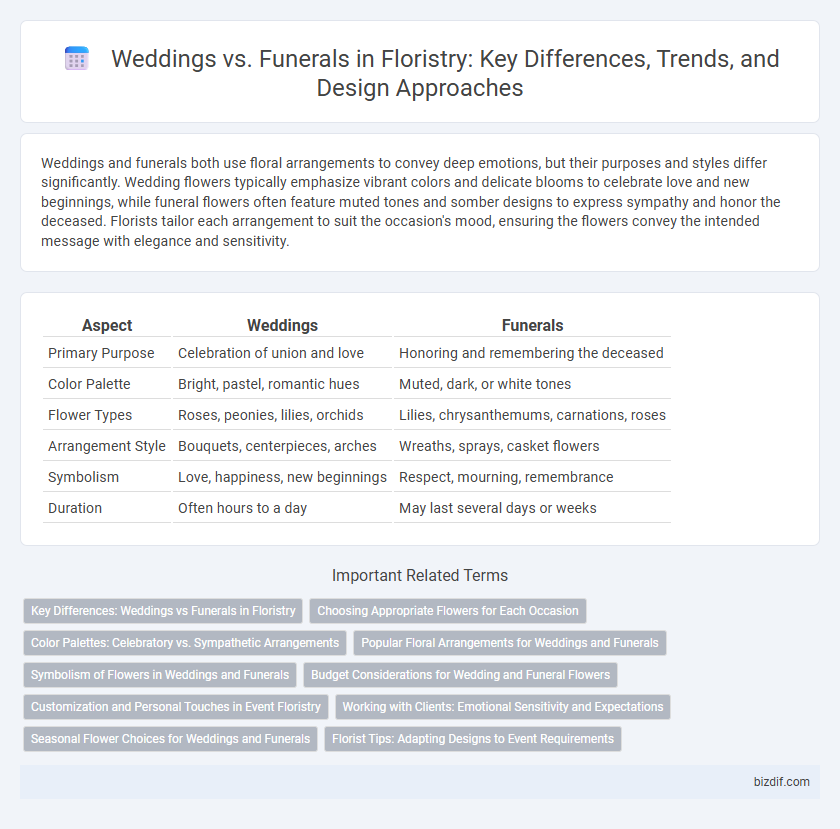Weddings and funerals both use floral arrangements to convey deep emotions, but their purposes and styles differ significantly. Wedding flowers typically emphasize vibrant colors and delicate blooms to celebrate love and new beginnings, while funeral flowers often feature muted tones and somber designs to express sympathy and honor the deceased. Florists tailor each arrangement to suit the occasion's mood, ensuring the flowers convey the intended message with elegance and sensitivity.
Table of Comparison
| Aspect | Weddings | Funerals |
|---|---|---|
| Primary Purpose | Celebration of union and love | Honoring and remembering the deceased |
| Color Palette | Bright, pastel, romantic hues | Muted, dark, or white tones |
| Flower Types | Roses, peonies, lilies, orchids | Lilies, chrysanthemums, carnations, roses |
| Arrangement Style | Bouquets, centerpieces, arches | Wreaths, sprays, casket flowers |
| Symbolism | Love, happiness, new beginnings | Respect, mourning, remembrance |
| Duration | Often hours to a day | May last several days or weeks |
Key Differences: Weddings vs Funerals in Floristry
Wedding floristry emphasizes vibrant, celebratory arrangements featuring roses, peonies, and lilies symbolizing love and new beginnings, often designed in bright, cheerful colors like white, pink, and pastels. Funeral floristry prioritizes somber and elegant arrangements using chrysanthemums, lilies, and carnations in muted or dark tones such as white, purple, and deep red to convey sympathy and respect. The key differences lie in the choice of flowers, color palettes, and the overall emotional tone reflected in the floral designs.
Choosing Appropriate Flowers for Each Occasion
Selecting flowers for weddings emphasizes vibrant blooms like roses, peonies, and lilies, symbolizing love, joy, and new beginnings. In contrast, funerals often feature chrysanthemums, carnations, and lilies to convey sympathy, respect, and mourning. Understanding the cultural significance and color symbolism of each flower ensures appropriate floral arrangements that honor the occasion's emotional tone.
Color Palettes: Celebratory vs. Sympathetic Arrangements
Weddings often feature vibrant color palettes such as blush pinks, creamy whites, and lush greens to evoke joy and celebration, while funerals typically use subdued tones like deep purples, whites, and soft blues to convey sympathy and respect. Floral arrangements for weddings emphasize bright blooms such as roses, peonies, and lilies to symbolize love and new beginnings, whereas funeral designs incorporate chrysanthemums, carnations, and lilies of the valley to express mourning and remembrance. The choice of color palettes plays a crucial role in setting the emotional tone for these distinct occasions in floristry.
Popular Floral Arrangements for Weddings and Funerals
Popular floral arrangements for weddings often include elegant roses, peonies, and lilies arranged in bouquets, centerpieces, and arch decorations symbolizing love and celebration. Funeral floral displays typically feature chrysanthemums, carnations, and lilies arranged in wreaths, sprays, and casket adornments to convey sympathy and remembrance. Both occasions use florals to evoke emotion, but wedding flowers emphasize joy and new beginnings, while funeral arrangements focus on honoring and mourning.
Symbolism of Flowers in Weddings and Funerals
Flowers in weddings symbolize love, new beginnings, and fertility, with roses representing passion and lilies conveying purity and commitment. In funerals, flowers serve as a tribute to the deceased, expressing condolences and eternal remembrance, with chrysanthemums often symbolizing grief and respect. The choice of blooms in both ceremonies reflects deep cultural meanings tied to life, death, and emotional expression.
Budget Considerations for Wedding and Funeral Flowers
Wedding flowers typically demand a higher budget due to elaborate arrangements, seasonal varieties, and customization for ceremonies and receptions. Funeral flowers often prioritize simplicity and affordability, focusing on sympathy wreaths or sprays that convey respect without excessive cost. Understanding these budget distinctions helps clients allocate resources effectively, balancing emotional significance with financial planning for both occasions.
Customization and Personal Touches in Event Floristry
Customization in wedding floristry emphasizes vibrant, themed arrangements with personalized blooms reflecting the couple's style, while funeral floristry prioritizes subdued, respectful designs that honor the deceased's memory. Personal touches at weddings often include monogrammed ribbons, signature flower choices, and bespoke bouquets, whereas funerals feature meaningful floral tributes like favorite flowers or symbolic colors. Both events rely on tailored floral artistry to convey emotion, enhance the atmosphere, and create lasting impressions unique to each occasion.
Working with Clients: Emotional Sensitivity and Expectations
Floral designers must navigate the distinct emotional landscapes of weddings and funerals, balancing joyous celebration with solemn remembrance. Understanding client expectations involves recognizing that wedding arrangements emphasize vibrant, personalized aesthetics, while funeral florals require respectful, understated compositions. Effective communication and empathetic listening ensure florists provide meaningful support tailored to these profoundly different occasions.
Seasonal Flower Choices for Weddings and Funerals
Seasonal flower choices for weddings emphasize vibrant blooms like peonies, roses, and lilies in spring and summer, creating romantic and joyful arrangements. Funerals often feature elegant, somber flowers such as chrysanthemums, carnations, and orchids, available in autumn and winter to convey respect and remembrance. Selecting flowers that peak in season ensures freshness and aligns with the mood of the event, balancing beauty and significance.
Florist Tips: Adapting Designs to Event Requirements
Florists specializing in weddings emphasize vibrant, fragrant blooms like roses, peonies, and lilies arranged in lush, romantic styles to complement bridal themes and photo aesthetics. In contrast, funeral floral designs prioritize subdued colors, such as whites and pastels, featuring chrysanthemums, carnations, and lilies arranged in respectful, symmetrical wreaths or sprays to convey sympathy and honor. Adapting to each event's emotional tone, florists adjust flower selection, color palettes, and arrangement structures to meet client expectations and cultural sensitivities.
Weddings vs funerals Infographic

 bizdif.com
bizdif.com